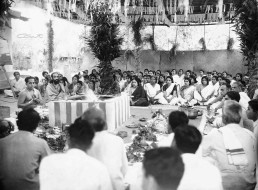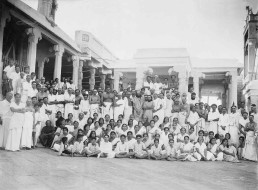
Jnana Yajna 4

Year & Dates:
January 7, 1954 to January 27, 1954

Yajna Topics:
Ishavasya Upanishad

Place:
Palakkad, India.
From the cosmopolitan setting of Delhi to the conservative, diffident crowd in Palghat, the revival was on the move. A Vedantic wildfire was ignited by Pujya Gurudev Swami Chinmayananda across diverse audiences. He wanted the all-pervasive Knowledge to reach the maximum without any bias. In His preliminary talks before He introduced Isavasyopanishad to the Palghat public, He challenged: “I want neither your faith in nor your devotion for the ancient scriptures to be brought into this Yagnasala to stultify or color your poor discrimination; bundle them away! Come here with a sharp and pointed intelligence; thirsty to know and willing to strive.”
Scientific and Vivid Logic
To the many who looked upon Hinduism as an orthodox bundle of rituals and superstitions, His approach of uncompromising and scientific logic enhanced by familiar life examples was first intriguing and then became deeply interesting.
In the vibrant 21-day yajna at Palghat, Pujya Gurudev carried the audience of Palghat on an exciting voyage as He described and explained the five ‘waves of thought’ in Isavasyopanishad. The first tall wave of the ‘Route to Renunciation’ that the rishis extolled was followed by the second sincere wave of the ‘Path of Action.’ The vivid portrayal of the highest goal of life was the third, transcendental wave. Knowledge reinforced by devoted action would yield maximum dividend, emphasized the fourth wave. The fifth, final wave of thought was the triumphant transition from mortal manhood to immortal Godhood!
The different elements of His Jnana Yajna left an unforgettable impression in the minds of the Palghat people who dived into Self-Awareness, worshiped together in the concluding Havan (Homa), and were inspired to seek and recognize the Omnipresent Divine in everything around!
In Admiration
Shri A S Menon from Palakkad remembers his first memories of Pujya Gurudev Swami Chinmayananda, “The striking feature in Swami Chinmayananda that has charmed me is the scintillating expression of joy in his face – a face which is impervious, to an astonishing degree, to attacks of despondency and gloom. Not that situations which would give rise such feelings were lacking in Swamiji’s life.”
Photo Gallery

“Think,” Says Pujya Gurudev
The Gyana Yagna is thus a movement of renaissance rather than an attempt at creating a sect of compromisers trying to build up a limited cocoon to bury themselves in! We shall in the first three days go into these general definitions, which are absolutely necessary in understanding the chosen text, and thereafter plunge ourselves into the main textbook itself: The Ishavasya Upanishad
From Ishavasya Upanishad Book, p. 16
I am sure that I have now made it amply clear how far our enquiry would be interesting and fruitful, not only to ourselves but to the world at large, in case we undertake this work in a pure spirit of research and scholarship. I want neither your faith in nor your devotion for the ancient scriptures to be brought into this Yagnasala to stultify or colour your poor discrimination; bundle them away! Come here with a sharp and pointed intelligence; thirsty to know and willing to strive.
OM TAT SAT
From Ishavasya Upanishad Book, p.21
Upanishadic Teachings on the Ineffable
Explore the enigmatic world of the Upanishads, where the sages use language not to define but to point towards the indescribable Reality. Immerse yourself in the subtlety of their expression, guiding your mind into a contemplative state that transcends conventional understanding. An excerpt from Ishavasya Upanishad talk series at Berhampur in 1983.


